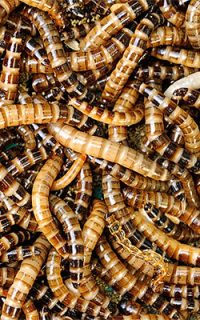
This iteration of the material was specifically designed to package beef, of which Brazil is a major producer, but could be applied to other food products. It’s still widely used owing to its abundance, low cost and excellent film-forming properties,” says chemist and materials scientist Márcia Regina de Moura Aouada. “Gelatin was one of the first materials used in the production of biopolymers. molitor has four stages egg, larva, chrysalis, and adult resulting in a complete transformation. Fill it with bran flakes/oatmeal and toss in your fresh. Keep them in a big Tupperware container with a hole cut out on the lid, with wire mesh glued to it to make a window. Nanoclay was added to give the film double the strength of conventional polyethylene packaging films, and a nano emulsion of black pepper essential oil helped improve flavor and extend shelf life. Mealworms (yellow mealworm) are the larvae of Tenebrio molitor, which can be found all over the world, including Korea 9. I dont see how mealworms are any different than any other many legged invertebrate we have no problem eating (shrimp, lobster, crabs) Mealworms are easy as fuck to raise. The group, comprised of scientists at the University’s Composites and Hybrid Nanocomposites Group, used widely available gelatin as a base. They say the material is edible, biodegradable, anti-microbial and higher performing than petro-based incumbents.

In Brazil, researchers at São Paulo State University have made a food packaging material from gelatin, clay and black pepper essential oil. That’s how closely related they are.#4 Pepper-infused bioplastic film developed for beef packaging That’s why you shouldn’t be eating them if you’re allergic to shellfish. “Think of it as land shrimp! From an evolution perspective, mealworms are nothing more than a shrimp that hopped on land a long time ago and became an insect.

Mealworms are a popular feeder insect for reptiles. The Styrofoam was efficiently degraded in the larval gut within a. Mealworms are the brown worm-like larvae of mealworm beetles, a species of the darkling beetle. Livin Farms founder Katharina Unger knows that the very idea of growing, harvesting and – yes – eating bugs is a big no-no for many of us. Mealworms (the larvae of Tenebrio molitor Linnaeus) from different sources chew and eat Styrofoam, a common PS product.

Even better, the food you harvest matches the protein content of beef but without the environmental downside of raising cattle. You don’t have to walk all the way to your allotment or even your own back garden to harvest your food because their ‘hive’ sits right on your kitchen table or desk. Livin Farms gives a whole new meaning to home grown.


 0 kommentar(er)
0 kommentar(er)
